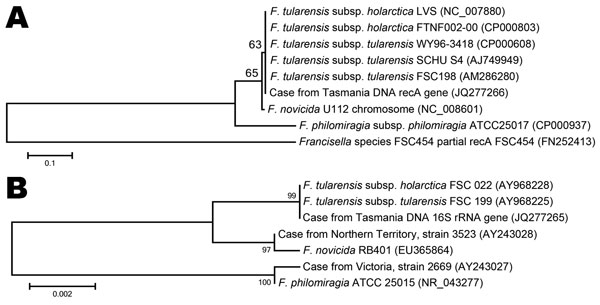Volume 18, Number 9—September 2012
Dispatch
Francisella tularensis Subspecies holarctica, Tasmania, Australia, 2011
Figure 2

Figure 2. . Nucleotide sequence comparison of the recA (A) and 16S rRNA (B) genes of Francisella tularensis subspecies holarctica, Tasmania, Australia, 2011. Reference sequences from the GenBank/European Molecular Biology Laboratory/DNA DataBank of Japan databases and 16S rRNA gene sequences from an F. novicida and an F. philomiragia infection reported from Australia (4) were aligned with amplicons of 16S rRNA and recA genes from samples with PCR results positive for F. tularensis from a 44-year-old woman. Scale bars indicate nucleotide substitutions per site.
References
- Keim P, Johansson A, Wagner DM. Molecular epidemiology, evolution, and ecology of Francisella. Ann N Y Acad Sci. 2007;1105:30–66. DOIPubMedGoogle Scholar
- Huber B, Escudero R, Busse H-J, Seibold E, Scholz HC, Anda P, Description of Francisella hispaniensis sp. nov., isolated from human blood, reclassification of Francisella novicida (Larson et al. 1955) Olsufiev et al. 1959 as Francisella tularensis subsp. novicida comb. nov. and emended description of the genus Francisella. Int J Syst Evol Microbiol. 2010;60:1887–96. DOIPubMedGoogle Scholar
- Whipp MJ, Davis JM, Lum G, de Boer J, Zhou Y, Bearden SW, Characterization of a novicida-like subspecies of Francisella tularensis isolated in Australia. J Med Microbiol. 2003;52:839–42. DOIPubMedGoogle Scholar
- Broekhuijsen M, Larsson P, Johansson A, Byström M, Eriksson U, Larsson E, Genome-wide DNA microarray analysis of Francisella tularensis strains demonstrates extensive genetic conservation within the species but identifies regions that are unique to the highly virulent F. tularensis subsp. tularensis. J Clin Microbiol. 2003;41:2924–31. DOIPubMedGoogle Scholar
- Petersen JM, Schriefer ME, Araj GF. Francisella and Brucella. In: Versalovic J, editor. Manual of clinical microbiology. 10th ed. Vol. 1. Washington (DC): ASM Press; 2011. p. 751–69.
- Johansson A, Berglund L, Sjöstedt A, Tärnvik A. Ciprofloxacin for treatment of tularemia. Clin Infect Dis. 2001;33:267–8. DOIPubMedGoogle Scholar
- World Health Organization. WHO guidelines on tularaemia. Geneva: The Organization; 2007 [cited 2012 Jun 29] http://www.who.int/csr/resources/publications/WHO_CDS_EPR_2007_7.pdf
- Maurin M, Pelloux I, Brion JP, Del Banõ JN, Picard A. Human tularemia in France, 2006–2010. Clin Infect Dis. 2011;53:e133–41. DOIPubMedGoogle Scholar
- Kuroda M, Sekizuka T, Shinya F, Takeuchi F, Kanno T, Sata T, Detection of a possible bioterrorism agent, Francisella sp, in a clinical specimen by use of next-generation direct DNA sequencing. J Clin Microbiol. 2012;50:1810–2. DOIPubMedGoogle Scholar
- Pérez-Castrillón JL, Bachiller-Luque P, Martín-Luquero M, Mena-Martín FJ, Herreros V. Tularemia epidemic in northwestern Spain: clinical description and therapeutic response. Clin Infect Dis. 2001;33:573–6. DOIPubMedGoogle Scholar
- Akalın H, Helvacı S, Gedikoğlu S. Re-emergence of tularemia in Turkey. Int J Infect Dis. 2009;13:547–51. DOIPubMedGoogle Scholar
- Reintjes R, Dedushaj I, Gjini A, Jorgensen TR, Cotter B, Lieftucht A, Tularemia outbreak investigation in Kosovo: case control and environmental studies. Emerg Infect Dis. 2002;8:69–73. DOIPubMedGoogle Scholar
- Cabelli VJ, Hodapp FA, Ferguson EW, Peacock M. Tularemia: potential for transmission by birds. Zoonoses Res. 1964;3:99–124.PubMedGoogle Scholar
Page created: August 27, 2012
Page updated: August 27, 2012
Page reviewed: August 27, 2012
The conclusions, findings, and opinions expressed by authors contributing to this journal do not necessarily reflect the official position of the U.S. Department of Health and Human Services, the Public Health Service, the Centers for Disease Control and Prevention, or the authors' affiliated institutions. Use of trade names is for identification only and does not imply endorsement by any of the groups named above.